Opal Cutting and Polishing
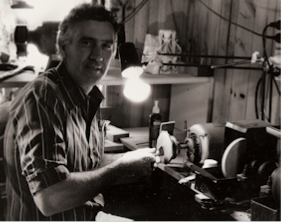
Opal Cutting and Polishing: This appeals to certain folks who like to learn new hobbies and know that in today’s economic climate it can be a way of either making a few extra dollars in the garage or at least using their productions as items to give away.
Opal Gems hold international appeal, obviously because of their amazing change of color and adaptability to different outfit preferences.
Hence you can guarantee to produce a gift that will be much appreciated.
Gemstone cutting, of course, encompasses all varieties of precious items such as sapphires, rubies, emeralds, etc, but most of these items require a very high degree of time and skill that is not always so rewarding.
Satisfaction from Opal Cutting There’s nothing more exciting than to take a rough piece of opal with remnants of the ground it came from attached, and with a few simple machines, turning it into a magnificent opal jewelry (jewellery) piece.
And keep in mind that if you do become an expert it won’t be long before you gather quite a few loose opals that you can select from to fit the personality of the person you are giving it to. You have to get used to terms such as ‘lapidary rough’ and ‘lapidary supplies’ as the term ‘lapidary’ has to do with the production of cut gemstones.
Opal Gem Jewelry creations are your goal and with a bit of effort, you can find where to get pendant chains and accessories so that the piece you have made can be installed in a gift box with an appropriate card.
As precious as these gems are, they don’t have to be really difficult to cut and polish. Australian opal rings and pendants along with other accessories are a real delight to produce and deal with.
You can also offer your stones for sale online as well as in your local newspaper, particularly the classified ads. Rough opal is available on this site if you want to experiment with opal cutting.
Opal Cutting and Polishing Procedure
If you see yourself becoming an expert cutter, continue reading this extensive article which will introduce you to the methods and machinery necessary to pursue your goal.
If you can afford $35 after you have read this article you can order the cd: ‘the ordinary bloke’s guide to opal’ which will give you over 30 years of experience in the opal and opal jewelry or jewellery business. (‘jewellery’ is the English spelling and ‘jewelry’ the US spelling of this word)
If you happen to have some rough of your own and you don’t want to learn how to cut it yourself, you can take advantage of our opal cutting and photography service described later in this article. Keep in mind that there is now an eBook available instead of the CD. Free to opalmine customers.
Making sure you get a good polish
The term ‘opal cutting’ might seem to indicate that it refers to someone who just cuts through a stone with some sort of saw but there is a lot more to cutting rough opals than just making an incision. We are talking about lapidary rough opal that needs to be processed to produce designer cabochons.
The fact is that the term is a bit misleading because it is used to describe a lapidary that is a cutter and or engraver of a stone. And it must be said that a gem cutter does much more than just cut stones.
The art usually starts when someone sets eyes on the stone itself. To anyone with an eye for beauty, this initial contact with the stone leaves a memorable impression. Some just desire to own the stone set in a pendant or a ring. Others want to take it further and learn all about its history, its locations, its mining potential, hot is processed from the rough state to a finished opal gem.
Focusing on the cutting process itself, the idea is to take a piece of rough opal in your hand, often from a parcel of stones bathed in water. In most cases, it’s necessary to use water on the stone because it gives a clearer picture of the stone you are examining. Unless you have very good dyes, a pair of jeweler’s magnifying glasses will help to identify faults and help you make a decision about where to make the first incision.
A quick word about the cutting procedure itself. In case you are not familiar with sintered diamond blades. These are metal blades that have an edge made up of a mixture of metal and diamond (as opposed to plated wheels, which as the description implies have diamond dust plated on the outside of the metal, not actually enclosed in the metal, and this tends to wear off sooner. So if you are thinking of becoming a serious cutter, get the best blades.

Diamond blades need water to be run over them to operate properly because the blade has to be kept cool while it does the job of slicing through hard material although it must be said that opal, in contrast to most other stones, is a pleasure to cut and does not wear your blades out as much as (for example) agate, chrysoprase, chalcedony, etc.
After some practice, the cutter will get the ‘feel’ of the blade and avoid putting too much pressure on it and jamming it. Just allow the blade to find its own way through the stone without forcing it because this could produce disastrous results, such as a broken gem, a broken blade, and maybe a cut finger.
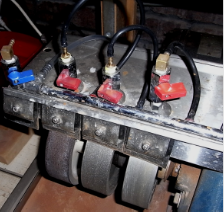
Depending on the rough stones you have, opal cutting and polishing can either start with the diamond blade or with the grinding machine. Sometimes you have to use the grinder to clean up the stone a bit so that you can either expose the color more or see where there are any cracks and inclusions.
Then you can slice the stone to suit. But sometimes it’s obvious what should be done and you can start with the blade. The two machines work in tandem, checking for color and deciding what the front and the back of the stone will be.
After the cutting procedure is complete, the stones potential is more exposed and you are ready to take it to the next stage which is the grinding wheel.
Make sure you have good lights over your work, keeping in mind that you are working with water so it’s wise not to have electrical equipment too close to your work. Some nowadays are opting for 12v lighting systems to improve safety in this area.
Whether you are using the old style carborundum wheels or the new style diamond wheels, the same principle applies. To make sure there is plenty of water poring over your work to avoid overheating and to get the best grinding results.
During the process, you are cleaning up the stone more. Stopping regularly to examine for faults, cracks, and inclusions. Your goal is to get as much color out of the stone as possible without leaving unnecessary inclusions that will take away from its beauty.
To achieve this goal, it’s a good idea to have in mind what you are going to do with the stone when it’s complete. For example, are you going to set it into a pendant or a ring? Is your main concern to get the most color out of the stone or do you want a particular shape such as an oval or a square stone?
Keep in mind that if you make an oval, you are going to waste some material because all edges have to be ground away. On the other hand, if you leave it free form, it may be more difficult to set because the jewelry piece might have to be handmade instead of caste, which can be more expensive.
More on jewelry setting can be found in the ‘opals for the ordinary bloke’ CD, which is now available online to select customers. Please leave your details here if you are interested.
Free forming opal by hand can be a delightful experience and brings out the creativity in you when you get away from the standard shapes. And of course if you venture into the art of jewellery or jewelry (depending on how you spell it either the Australian or American way) making, the creativity just explodes. It won’t be long before you will be known as ‘The Opal Man’ in your community.
If you are going to become a professional opal cutter, you have to learn how to cut perfect ovals without drawing them. Of course, you can use a template when you start off but after a while, your eye will get used to perfect shapes and you won’t have to keep using the template after a while.
To achieve this goal you can experiment and practice with lots of cheaper stones that you can cut out of the colorless potch or ironstone that will come with most parcels.
As soon as the stone has been fashioned by hand, now is the time to take it to the next level, which means putting in on a small piece of wood that is called a ‘Dop Stick.’ Before you do this you will have to cut yourself a bunch of these sticks out of dowels that you can buy from the hardware store. Some perhaps ¼” diameter.
Others a little thicker, right up to the thickness of a broom stick for larger stones. So that you don’t have to have a dop stick holder with different thicknesses of holes which would be a pain, you just make a blunt point on the end of each stick so that they all fit the same hole in the Dopstick stand (bottom left)
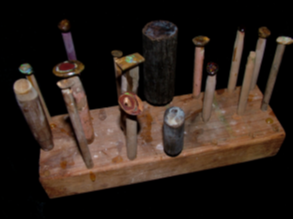
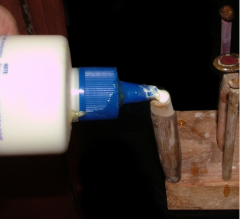



Of course, if you have a bunch of stones, it’s better to dop them all at once so that they can all dry together, giving you plenty of work to do the next day without having to wait for them to dry.
You can use the old Metho and ceiling wax system if you want to have it ready in a few minutes but this is tedious and time wasting. This system is explained fully in our CD “the Ordinary Blokes Guide to Opal”
The machinery you use for the next steps that bring you to the final polish is pictured below. The grey, orange, and pink wheels to the left are the three last steps in bringing the opal to completion, but some still use the old fashioned cerium oxide as a final polish over and above diamonds.
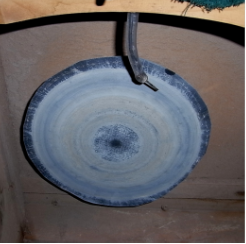
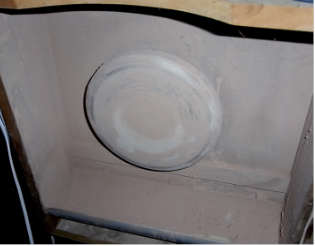
Some opal cutters such as myself still prefer the old wet and dry sanding disc shown on the left, and the cerium oxide leather lap on the right.
Even if you use the diamond machines for the first part of the process I still find that finishing off with these old reliable methods give a better final polish.
The most important sandpaper grits to use in my opinion are 320 and 600 before the final polish. 320 is so important to make sure all deep scratches are out and 600 just gives it that nice clean up before the cerium oxide.
You have to experiment with different papers from different manufacturers. We always liked the old Nikon paper or Matador from Germany but these are no longer available as far as I know in Australia but may be where you live.
We are currently using Norton paper here which seems OK but some papers are just no good for lapidary opal cutting for some reason. So just buy a few different types and experiment. It won’t be long before you get the ‘hang’ of it.
As far as obtaining rough opal from Coober Pedy and Lightning Ridge as well as opal jewellery, you can check out our site and you can buy loose natural opal, benefit by a world gem cutting service and if you don’t want to do it yourself, have your opal cut for low prices.
And you will be pleased to know that we are currently planning to set up opal auctions. Because opal cutting is always associated with lapidary rough rock, you need to get diamond lapidary tools and machinery from Lapidary suppliers. Leave a message on the Chat Forum below and Peter will help you with this.
Lightning Ridge – History, mining, traveling are all terms we use to get to know about the opal industry and of course, you could add Coober Pedy, Winton, Koroit, Yowah, Quilpie, Andamooka, White Cliffs and others to that list.
Leave a message on the blog below if you would like to get a copy of our new movie on the subject of opal cutting.

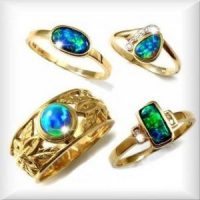





IS there anyway to remove cracKs ftom finishef polishef opal?
Jackie, not really. Some have tried by heating them and soaking them in thin epozy resin called opticon but I haven’t seen it work successfully. Take a look here, you might find some ideas. Hope it works well for you Jackie, peter
Hi, we have spent a few years travelling and have quite a collection of rough opal we’ve found around Australia. We’d like to but some lapidary equipment to start learning cutting and polishing. What are the best for BEGINNERS to use? I’ll be definitely purchasing the book to guide us. We aren’t able to access a lapidary group at the moment. We have lots of ironstone rough with opal to practice along with others from other areas in Aus. Also if we purchase a machine is it also able to polish other gems like sapphire, zircon etc? Any info would be appreciated
Kath sorry for late reply. do a search for lapidary equipment and let me know what you find. opals are cut with a dome top so the machinery is different to faceted gems. we do appreciate a five star recommendation to help us continue this free service. peter
Hi do you offer opal cutting?
Steve the jeweller
steve sorry for late reply. yes we do opal cutting. contact me on the live chat on the front page peter
Am interested in opals and vave access to some blacks. Cant find a lapidary supply where i live in chiangmai thailand
Steve i take it that your black opals are still in the rough? Do you want to have them cut and polished? First though you have to find out where they are from because some opals outside Australia are no good for cutting. try to send a close up picture and i will take a look. be sure to crop the picture and reduce its size to around 100 to 200 kb. Peter
I just bought some cabs, & someone said that after polishing Louisiana Opal, soak it in simple green, ammonia and water for a few days to clean the pores. Wipe dry and soak in acetone for a few more days. They said the stone gets much brighter. Do you agree with this? Thanks, Karen
regarding Louisiana opal Sorry Karen, i dont know anything about this type of opal as my expertise is in Australian opal. I believe that this type of opal is quite porous and would need treatment to avoid cracking. I dont know what green ammonia is, and i’m sorry not to be of more help. I have heard of an epoxy filler called Opticom that some use for porous stones but not sure if that would help. but please let us know how you go on this forum for the benefit of others. thanks Karen, Peter
regarding dry sanding of opal. yes, we always used to sand dry with coober pedy white or crystal and in most cases no problems. i feel happier though using water based diamond nowadays. particularly with boulder opal which is more of a challenge to polish.
haven’t worked with welo opal. only other Ethiopian opal that breaks immediately but i understand that welo is more secure. but loses color after soaking in water. is that right? peter
Hello, if possible, could you please explain about the special tools for polishing and polishing inside the agate gem line. Thank you.
معذرت، میں آپ سے جاننا چاہتا تھا کیا نہیں سمجھ سکے
Hi Peter,
Your article was very helpful for me, thank you. I have just started a custom made opal jewellery business based where I live in Chiangmai, Thailand. Up to this point I have just been buying stones online and taking them to my silversmith to be transformed into jewellery, but I would really like to start cutting and polishing my own opals. Feel free to check out my facebook page Chok Dee Opals. I would really appreciate a copy of of the blokes guide to opals, and any other helpful resources you could put me onto.
Kind regards,
Luke
Luke. regarding opal sales in Thailand. I was there not long ago and can see a large potential particularly with the amount of European and American tourists there now. if you like, send me an email direct to peterATopalmine with dot com after it. sorry i have to express it this way but we are having too much trouble from spammers. i will send you a copy of the book and the movie. Where are you located in Thailand? I spent a few weeks in Chiang Mai a couple of years ago. Great place! best wishes Luke, peter
Well, regarding opals, I think all those procedures are worth it..
But my person discovered blue opal or blue chalcedony. In my country, there is no expert in the matter. Please, if you could help me, my email is agustin_arando@hotmail.com I will be very grateful for all this
regarding opal cutting, You will need to find someone who can read English and take a look here. http://issuu.com/brusaschi/docs/opal_bloke_book-free_version-revised and here: http://www.youtube.com/watch?v=iEjL8N1Zi00&feature=youtu.be best wishes,
Usted tendrá que encontrar a alguien que sepa leer Inglés y echar un vistazo aquí. http://issuu.com/brusaschi/docs/opal_bloke_book-free_version-revised y aquí: http://www.youtube.com/watch?v=iEjL8N1Zi00&feature=youtu.be mejores deseos,
Hello, I would like to know where I can purchase semiprecious stone cutting machines and ultrasonic drilling machines. Please, if someone could guide me, I would greatly appreciate it..
Heladio, this is the best place to search for them: http://www.gemcuts.com.au/ https://www.google.com.au/webhp?source=search_app&gws_rd=cr#output=search&sclient=psy-ab&q=lapidary+equipment+china&oq=lapidary&gs_l=hp.1.1.35i39l2j0j0i20j0l6.3709.5140.1.7782.8.8.0.0.0.0.266.1936.2-8.8.0….0.0..1c.1.20.hp.Sm0xfaCtyHE&psj=1&bav=on.2,or.r_cp.r_qf.&bvm=bv.49478099%2Cd.aGc%2Cpv.xjs.s.en_US.c75bKy5EQ0A.O&fp=41d591572811c6f7&biw=1920&bih=947 China es el más barato. si es muy difícil hablar con ellos puede que tenga que obtener de australia. si es así que por favor póngase en contacto conmigo de nuevo peter http://www.alibaba.com/showroom/ultrasonic-drilling-machine.html
hello would like to know where I can purchase stone cutting machines Ultrasonic perforadore emiprecioas and please if someone could guide and would greatly appreciate it.
Heladio, are you experienced with importing from other countries? where are you located? In Spain or maybe South America. Heladio, ¿tienes experiencia con la importación de otros países? ¿Dónde están ubicados? En España o tal vez América del Sur. Peter
if you are working with light colored opal you will need to calibrate them to popular sizes to compete with coober pedy in australia. if you are selling in america, most of the manufacturers work with castings which means the stones need to be cut to the most popular calibrations such as 7×5, 8×6, 9×7,10×8,12×10,14×10,18×13 Just to give you a tip. hope you do well over there. peter
I have looked at some Ethiopian Opals with a friend who is willing to sell them. I am a dealer in gems but have never experienced in dealing in Opals. After reading your article I am motivated. But my problem is that this lot has been kept in a polythene bag without submersing in water. These are all in rough form what you may call “concrete “. Do you think crazing or cracking would have taken place and which is the best method to inspect the insides.
Thanking you for an early advice
Almhashim: be careful with opals from this area. they are similar to Tintenbah opals in Australia. I have tried cutting them in the past and they always crack. some claim that you can get some safe stones but its too risky to try. Stick to known secure opal fields and leave these opals just for specimens and curiosity. At least thats my measured opinion.
I have a large colllection of opal [most rom down under] alot are worl class and hope to start cutting and polishing real soon—-are large opals better left largeor should they be cut [talking 500 thru 2100 ct stones]all are rough and beautiful now but will be even better polished]large or small which sells the best and for the highest amount Thank you R.H. McCollum ps would like info on movie
Roy. just making sure you got my answer about your opal inquiry. let me know if not. best wishes, Peter
Thank You Peter aand yes I did get your answer and will try and get some pix’s of them for you My good camera is in getting fixed but am going to see what I can come up with !!1 This is oneof the best sites Ive found for real info Thank YOou for your great help!!!!!!!!
No problems Roy. Opal is not an easy stone to photograph so please go to the opalmine site for some advice on this here: http://opalmine.com/services/opal-photography/ Hope that helps. Peter
Enjoying your info. I have some rough opal that I bought 30 years ago mostly Australian from various locations. Im now in Costa Rica and need to build a lapidary machine. Also need to get polishing supplies. Anyone know how to convert a 60hz 3450 RPM machine into a good lap machine using 6″ wheels with 1/2″ arbor to a 1750 rpm machine?
Deb sorry for the delay in answering your comments. we have had some technical issues with the site. please fill in the ‘contact us’ form from the dropdown at the top of this page so that i can email you back and talk to you about your rough opal. best wishes Deb, Peter
Dear Peter,
I love opals and would like to begin cutting and polishing as a hobby. Since I have no knowledge or experience, please advise me about the start-up cost and whether it is a lucrative hobby.
I am planning to get the rough stones from Africa.
Finally, is this a gender sensitive occupation ?
Thanks
Hawa (Mrs.)
Hawa sorry for the delay in answering your comments. we have had some technical issues with the site. please fill in the ‘contact us’ form from the dropdown at the top of this page so that i can email you back and talk to you about opal cutting. best wishes Hawa, Peter
Hawa, we have had a few technical problems in the blog of opalmine.com and i am just checking on some comments made. sorry for not getting back to you earlier. please comment again if needed. very best wishes Hawa, Peter
I have a greenstone pendulent that has sufferred some damage. Can you polish the broken end?
Mr. Kemp, The short answer is that it depends on the opal you are cutting. A lot of opal is coming from areas outside Australia and this opal will crack as soon as it goes anywhere near heat. But Australian opals from most fields are secure. you just have to make sure your source is reliable. But really, its not necessary to use the old fashioned wax system. You can use carpenters white glue. You just have to allow the opal to stand on the stick overnight and dont put too much water on it. Best idea is for you to leave your details here http://www.opals.co/contact-us/ and send me a reminder to the email you will see to the right of the contact form. I will arrange to send you a copy of my opal eBook where all these opal details are discussed thoroughly. . just make sure that your email system can handle 14 megs. Best wishes Mr. Kemp , Peter (please give me your first name if its OK)
Yes, i believe diamond is the way to go cutting opal in most cases nowadays. The only problem is that diamond wheels have a sharp edge unless you buy specialised round edged ones which can be costly and mean another addition to machines in sometimes cramped work environments. Sharp edged diamonds can waste a lot of material in boulder opal cutting which is really the way to go nowadays because of the demise of the Lightning Ridge black opal fields. The old carborundum wheels can be dressed so that the edges are rounded off. And focusing on the hills and valley undulations in boulder opal, its better to have a bit more control of the stone using a dopstick unless you are using flexidrive equipment which can slow up the process considerably. This has been my experience. maybe you have a different opinion which we would be delighted to hear. thanks again for your contribution to the forum Walter. Where do you live? Peter
Wow, thats amazing Walter. you sure must have nimble fingers. good point about harlequin opal. its referred to in the ‘opal bloke’ book but you usually have to buy the cd. no problems, i will send you an opal ebook by email but you will have to let me know if its ok to send 14meg. I’ll send you an email first so that we can make contact. The book has 30 years of experience in the opal industry so you will be able to compare notes with your own extensive experience. thanks for contributing to the forum Walter. expect an email soon. best wishes, Peter
I think, the most problem by cutting opals is to glue them on a stick. This glue you have to leave overnight, but mostly i need to cut the stones at once. So I use shellack.
Mikhail, yes, I understand what you mean. If you want to cut a stone right away you have to get it to stick on the Dopstick immediately. We used to use Ceiling wax which I believe is a mixture of Shellac and something else. You heat it up with a spirit lamp and fashion it using a cold metal blade or knife. You have to heat the stone a little at the same time and when the wax and the stone connect it only takes a short time for it to harden ready for cutting. The only problem with this system is that if you are using sandpaper, if you get any of the wax on the paper, it will wreck the paper so you have to make sure none of it goes around the stone. You can also use quick dry araldite instead of ceiling wax but you have to be careful taking it off the top of the stones when you are sanding the backs. If you aren’t careful you will pull some of the opal off. to avoid this, you can put the stone and stick into boiling hot water. But don’t try this on opal that is cracky. Australian opal can stand this but not opal that has too high a water content. Thanks for your comments Mikhail. Peter